![]()
![]()
![]()
Use LEFT and RIGHT arrow keys to navigate between flashcards;
Use UP and DOWN arrow keys to flip the card;
H to show hint;
A reads text to speech;
58 Cards in this Set
- Front
- Back
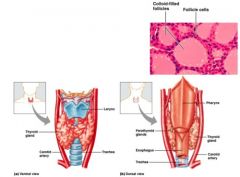
What do the follicle cells produce?
|
thyroid hormones
|
|
|
What are the thyroid hormones?
|
T₃ and T₄ (commonly called thyroxine)
|
|
|
What are the effects of thyroid hormone?
|
Primary effect — ↑ in metabolic rate
• ↑ O₂ consumption • produces heat as cell consumes more energy |
|
|
To meet this increased metabolic demand and ensure blood flow...
|
• ↑ heart rate and contraction strength (~ ↑ BP)
• ↑ respiratory rate • ↑ carbohydrates, fat & protein metabolism (need fuel) Important for nervous system & skeletal development, maturation of reproduction system and growth (works with GH) |
|
|
Thyroid Hormone Regulation
|
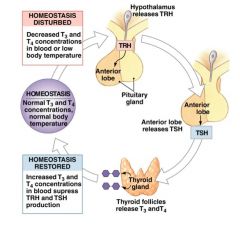
Negative feedback loop
|
|
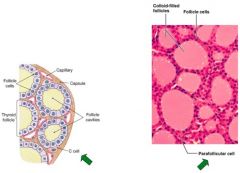
Parafollicular cells (C cells) produce the hormone _____.
|
calcitonin
|
|
|
What is the function of calcitonin?
|
lowers blood Ca²+ levels
• anatagonist to parathyroid hormone (PTH) |
|
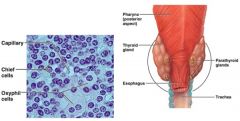
Parathyroid Gland
|
secretes parathyroid hormone (PTH)
|
|
|
Parathyroid hormone
|
raises Ca²+ levels in blood
• ↓ Ca²+ triggers PTH release • ↑ Ca²+ inhibits PTH release |
|

Control of Hormone Release
|
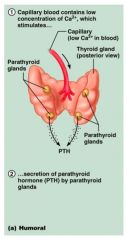
Humoral Stimuli: secretion of hormones in direct response to changing blood levels of ions and nutrients
Example: Ca²+ concentration in blood • ↓ Ca²+ in blood stimulates parathyroid glands to secrete PTH (parathyroid hormone) • PTH causes Ca²+ to ↑ ... and stimulus is removed |
|
|
Adrenal (Suprarenal) Glands
|
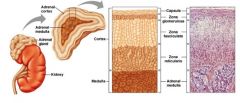
Structurally & functionally they are 2 glands in 1
• adrenal cortex • adrenal medulla |
|
|
adrenal cortex
|
glandular tissue
• synthesizes & release steroid hormones called corticosteroids 1. Mineralcorticoids (aldosterone) 2. Glucocorticoids (cortisol) 3. Androgens (sex steroids) |
|
|
adrenal medulla
|
neural tissue that acts as part of SNS
• synthesizes & releases catecholamine hormones 1. Epinephrine 2. Norepinephrine |
|
|
What are the three layers of the Adrenal cortex?
|
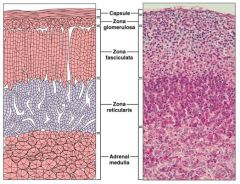
1. Zona glomerulosa
2. Zona fasiculata 3. Zona reticularis |
|
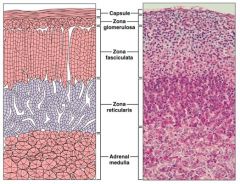
Zona glomerulosa
|

mineralocorticoids (cheifly aldosterone)
• promote Na+ retention and K+ excretion by kidneys ∙ removes Na+ from urine forming in kidneys & returns it to the blood ∙ exchanges K+ for Na+ at kidneys; K+ is excreted in urine |
|
|
Mineralcorticoids
|
regulate mineral & water balance
|
|
|
Aldosterone
|
most important mineral corticoid
Aldosterone secretion is stimulated by: • high blood K+ • low blood Na+ • ↓ blood volume or pressure Where Na+ goes, water follows: aldosterone also helps regulate blood volume & pressure |
|
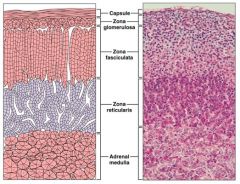
Zona fasiculata
|

glucocorticoids (chiefly cortisol)
Glucocorticoids - help body resist stress or intermittent food uptake by: • keeping blood glucose levels relatively constant • regulated by negative feedback Rising cortisol levels inhibit anterior pituitary (ACTH) & hypothalamus (CRH) |
|
|
Glucocorticoids
|

Glucocorticoids - help body resist stress or intermittent food uptake by:
• keeping blood glucose levels relatively constant • regulated by negative feedback |
|
|
What is the stimuli and effect of the zone fasiculata
|
Stimuli: stress or hypoglycemia cause CRH release
Effect: cortisol released to ↑ plasma levels of glucose, fatty acids & amino acids: 1) glucogenesis - glucose synthesis from fats and proteins in liver • especially between meals • glucose sparing effect - "save" glucose for brain 2) mobilize fatty acids from adipose tissue (for ATP production) 3) break down stored proteins (provides free aa for repair/enzymes) |
|
|
gluconegenesis
|
glucogenesis - glucose synthesis from fats and proteins in liver
• especially between meals • glucose sparing effect - "save" glucose for brain |
|
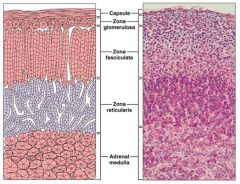
Zona reticularis
|

gonadocorticoids (chiefly androgens)
Gonadocorticoids (principally weak androgens) Weak androgens are converted into: • testosterone (males) • estrogens (females) ∙ Gonadocorticoids produced by adrenal gland = insignificant compared to amount from gonads |
|
|
What is the effect and regulation of the zone reticularis?
|
Effect: onset of puberty, appearance of secondary sex characteristics (7-13 years)
Regulation: release seems to be stimulated by ACTH (but gonadocorticoids do not seem to exert feedback inhibition on ACTH) |
|
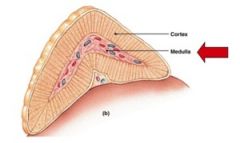
Adrenal medulla
|

• secretory activities controlled by sympathetic division of ANS
• Chromaffin cells - produce epinephrine (adrenaline) & noreinephrine Secretion of these hormones cause: 1) Blood glucose levels to rise 2) Blood vessels constrict 3) Blood diverted to the brain, heart, and skeletal muscle |
|
|
Secretion of chromaffin cells cause:
|
1) Blood glucose levels to rise
2) Blood vessels constrict 3) Blood diverted to the brain, heart, and skeletal muscle |
|
|
Chromaffin cells produce
|
epinephrine (adrenaline) & norepinephrine
|
|
|
What type of organ in the pancreas? (Endocrine and/or Exocrine)
|
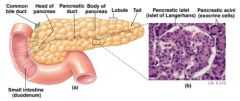
endocrine and exocrine organ
|
|
|
Exocrine (pancreas)
|
acinar cells produce enzyme-rich alkaline juice used for digestion
|
|
|
Endocrine (pancreas)
|
pancreatic islets produce hormones
|
|
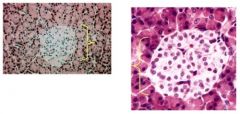
Pancreatic islets (islets of Langerhans) contain:
|

Alpha (α) cells and Beta (β) cells
|
|
|
Alpha (α) cells
|
produce glucagon
|
|
|
Beta (β) cells
|
produce insulin
|
|
|
What is the target, effect and regulation of glucagon?
|
Hyperglycemic agent: increases blood glucose
Target: liver Effect: •Glycogenolysis • Gluconeogenesis Glucose then enters the blood Regulation: stimulated by falling blood glucose |
|
|
glycogen
|
short-term energy storage of glucose
|
|
|
glycogenolysis
|
breakdown of glycogen to glucose
|
|
|
gluconeogenesis
|
synthesis of glucose
|
|
|
What is the target, effect and regulation of insulin?
|
Hypoglycemic agent - lowers blood glucose levels
Target: most cells of the body Effect: • Enhances transport of glucose into body cells • Stimulates glycogen formation at liver Glucose then leaves the blood Regulation: stimulated by rising blood glucose |
|
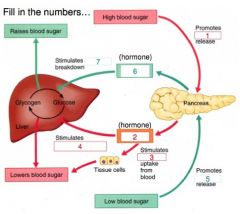
Fill in the numbers
|

1. insulin
2. insulin 3. glucose 4. glycogen 5. glucagon 6. glucagon 7. glycogen |
|
|
What is the function and stimulus of glucagon?
|
Glucagon: α cells
Function: ↑ blood glucose concentration Stimulus: low blood glucose concentration "When glucose is gone" |
|
|
What is the function and stimulus of insulin?
|
Insulin: β cells
Function: ↓ blood glucose concentration Stimulus: high blood concentration |
|
|
What is diabetes mellitus?
|
disorder results from insulin deficiency or resistance → leading to high blood glucose
|
|
|
What is diabetes insipidus?
|
disorder caused by hypo secretion of ADH (disables water conservation at kidneys)
|
|
|
Explain Diabetes Mellitus Type 1:
What is the Onset, Prevalence, β cells, treatment? |
Onset: Juvenile onset
Prevalence: 5-10% Cause: ~ auto-immune response β cells: Immune system destroys β cells → failure to produce insulin Treatment: |
|
|
Explain Diabetes mellitus Type 2:
What is the Onset, Prevalence, Cause, β cells, Treatment? |
Onset: Adult Onset
Prevalence: 90-95% Cause: Linked to sedentary lifestyle, poor diet, obesity β cells: Treatment: |
|
|
Pineal Gland
|
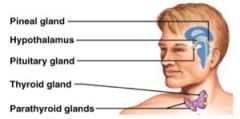
• Small gland hanging from roof of 3rd ventricle of brain
• Pinealocytes secrete melantonin |
|
|
What is melantonin?
|
• involved in day/night cycles (hight at night; low in day)
• physiological processes that have rhythmic variations (body temperature, sleep, appetite) |
|
|
What are female gonads?
|
Paired ovaries in abdominopelvic cavity produce estrogens and progesterone
|
|
|
What is the function of estrogens and progesterone?
|
• maturation of reproductive organs
• appearance of secondary sexual characteristics • breast development and cyclic changes in uterine mucosa |
|
|
What are male gonads?
|
testes located in an extra-abdominal sac (scrotum) produce testosterone
|
|
|
What is the function of testosterone?
|
• initiates maturation of male reproductive
• causes appearance of secondary sexual characteristics and sex drive • necessary for sperm production • maintains sex organs in their functional state |
|
|
What are some other hormone producing tissues?
|
1. adipose tissue
2. thymus 3. heart 4. kidneys 5. digestive system |
|
|
What two peptide hormones does adipose tissue produce?
|
Leptin and Resistin
|
|
|
What is leptin?
|
feedback control for appetite
• when you eat → leptin is released (= feel full) • some obese individuals appear to have defective leptin receptors |
|
|
What is resistin?
|
• decreased insulin sensitivity of body cells (insulin antagonist)
• was thought could be "missing link" between obesity and type II Diabetes |
|
|
What is the thymus?
|
produces hormone thymosin
• essential for T lymphocyte development & activity |
|
|
What hormone(s) is the heart responsible for producing?
|
produced natriuretic peptides (ANP/atrial NP & BNP/brain NP)
• both reduce blood volume & blood pressure |
|
|
What hormone is the kidney responsible for producing?
|
erythopoietin (EPO) - red blood cell production
|
|
|
What hormones is the Digestive System responsible for producing?
|
gastrin - coordinates digestive activities
secretin - coordinates digestive activity CCK - coordinates digestive activities |

